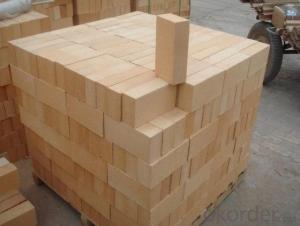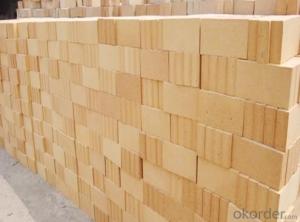High Alumina Refractory Brick Cutting Machine
- Loading Port:
- China main port
- Payment Terms:
- TT OR LC
- Min Order Qty:
- 30 m.t.
- Supply Capability:
- 2000 m.t./month
OKorder Service Pledge
OKorder Financial Service
You Might Also Like
CNBM conforms strictly to the requirements of ISO 9000 quality control system during the production. MSDS is also available if you want. The thermal insulation fire clay brick meet with the requirements of ASTM & JIS standards. So pls stay cool with our quality.
Insulating Fire Brick Technical index
Product No. | IFB70 | IFB60 | IFB50 | IFB40 |
Al2O3 | 68%-72% | 58%-62% | 48%-52% | 38%-40% |
Refractoriness (°C ) | ≥1790 | ≥1790 | ≥1790 | ≥1790 |
Bulk density (g/cm3) | 2.50-2.60 | 2.35-2.45 | 2.20-2.30 | 2.10-2.20 |
Apparent porosity (%) | 22 | 19-22 | 17-20 | 17-20 |
Cold Crushing strength (kg) | 480-510 | 450-480 | 430-450 | 390-430 |
Application
Insulating Fire Brick are used for the lining of converter, alternating current arc furnace, direct Current arc furnace and the ladle slag line, etc.
Equipment
1 unit of Ceramic Abrasive (SG Abrasive) pilot production line
2 units of Compact grain Abrasive pilot production lines
1 unit of high-end coated abrasives (abrasive cloth) production line
Company Advantage
(1)Long Insulating Fire Brick manufacture history: 25 years manufacturer
(2)Advanced equipment
(3)Diversification of production standards: ISO ANSI FEPA JIS ASTM
(4)Flexible payment: T/T L/C D/P D/A
(5)Professional marketing team and after-sale service
(6)Free sample
FAQs
Q1 |
What’s the transport method? |
A1 | FCL delivery goods with wooden pallet or wooden case by sea; If LCL delivery, must with wooden case; Sometimes need open top, flat rack or bulk cargo. |
Q2 |
What’s the required payment term? |
A2 | Generally 30% TT as the prepayment, 70% TT before delivery. If need, 100% Irrevocable Letter of Credit or negotiation. |
Q3 |
Which country are our products exported to? |
A3 | Apart from entire Chinese market, the US, Russia, Japan, Korea, Australia and some Southeast Asian Nations. |
- Q:Is it possible to cut insulating fire bricks to fit custom shapes?
- Yes, it is possible to cut insulating fire bricks to fit custom shapes. Insulating fire bricks are made from lightweight materials such as ceramic fiber, which can be easily cut or shaped using various tools. Common methods for cutting insulating fire bricks include using a saw, knife, or even a hot wire cutter. It is important to follow proper safety precautions and wear protective gear when cutting these bricks, as the cutting process may produce dust or sharp edges. With the right tools and techniques, it is possible to cut insulating fire bricks to fit any desired custom shape.
- Q:Can insulating fire bricks be used as a lining material for boilers?
- Insulating fire bricks have the capability to serve as a lining material for boilers. They are composed of lightweight refractory substances that possess exceptional insulating properties. The bricks are specifically constructed to withstand elevated temperatures, thus rendering them appropriate for usage in boilers, where temperatures can soar to several hundred degrees Celsius. By virtue of their insulating properties, these bricks aid in minimizing heat loss, thereby enhancing the energy efficiency of the boiler. Moreover, they exhibit resistance against thermal shock, a vital attribute for enduring the rapid fluctuations in temperature that transpire within boilers. Ultimately, owing to their remarkable insulating properties and capacity to endure high temperatures, insulating fire bricks emerge as a suitable alternative for lining boilers.
- Q:Can insulating fire bricks be used in cryogenic applications?
- Insulating fire bricks, also known as refractory bricks, serve primarily for high-temperature purposes and find common usage in furnaces and kilns. Nonetheless, when it comes to cryogenic applications involving extremely low temperatures, insulating fire bricks may prove to be unsuitable. Cryogenic temperatures, usually below -150 degrees Celsius (-238 degrees Fahrenheit), present distinctive challenges for materials due to the severe thermal stresses they endure. Insulating fire bricks typically consist of materials like alumina and silica, which possess limited resistance to thermal shock and can become brittle at exceedingly low temperatures. This brittleness exposes them to the risk of cracking and failure under cryogenic conditions. Furthermore, insulating fire bricks exhibit relatively high thermal conductivity, implying that they conduct heat rather efficiently. In cryogenic applications, where minimizing heat transfer is of utmost importance, materials with lower thermal conductivity are preferred. Consequently, insulating fire bricks, with their higher thermal conductivity, may not be the most effective choice for cryogenic applications. Instead, materials with exceptional thermal insulation properties and low thermal conductivity, like aerogels or foams made from silica or carbon, are often favored for cryogenic applications. These materials offer superior thermal insulation and better resistance to extreme temperatures, ensuring efficient and dependable performance in cryogenic environments. In conclusion, while insulating fire bricks find suitability in high-temperature applications, they may not be the optimal selection for cryogenic applications due to their brittleness at low temperatures and relatively high thermal conductivity. Materials specifically designed for cryogenic conditions, such as aerogels or foams, prove to be more suitable for these extreme temperature environments.
- Q:Are insulating fire bricks suitable for commercial or industrial applications?
- Insulating fire bricks are an ideal choice for commercial and industrial use. These bricks are specifically designed to withstand high temperatures and provide exceptional thermal insulation. They are commonly used in industries such as steel, cement, glass, and ceramics. In commercial settings, insulating fire bricks are frequently employed in kilns, furnaces, and ovens to ensure heat retention and energy efficiency. They help minimize heat loss, resulting in lower fuel consumption and cost savings for businesses. Additionally, their lightweight nature facilitates easy handling and installation, which is advantageous in time-sensitive commercial environments. In industrial applications, insulating fire bricks play a critical role in maintaining desired temperatures in industrial furnaces, reactors, and boilers. These bricks can endure extremely high temperatures, making them suitable for harsh industrial conditions. They also exhibit excellent resistance to thermal shock, preventing cracking or breaking when exposed to rapid temperature changes. Moreover, insulating fire bricks provide effective insulation against heat transfer, enhancing the overall efficiency of industrial processes. By reducing heat loss, they contribute to energy conservation and lower operating costs. Additionally, their durability and ability to withstand the demands of industrial operations make them a reliable choice for long-term use. In conclusion, insulating fire bricks are highly suitable for both commercial and industrial applications. Their exceptional thermal insulation properties, resistance to high temperatures, and durability make them the preferred choice in industries where heat retention, energy efficiency, and cost-effectiveness are of utmost importance.
- Q:Can insulating fire bricks be used in the construction of high-temperature reactors?
- Indeed, high-temperature reactors can incorporate insulating fire bricks in their construction. These bricks are explicitly engineered to endure elevated temperatures, rendering them apt for deployment in high-temperature settings like reactors. Their exceptional thermal insulation qualities contribute to minimizing heat loss and upholding the desired temperature within the reactor. Moreover, insulating fire bricks boast remarkable refractoriness, enabling them to endure intense heat without substantial distortion or harm. Hence, they represent an optimal selection for the construction of high-temperature reactors, wherein maintaining a steady and regulated temperature is vital for the reactor's effective operation.
- Q:Can insulating fire bricks be used in the construction of autoclaves?
- Yes, insulating fire bricks can be used in the construction of autoclaves. Autoclaves require materials that can withstand high temperatures and pressures, and insulating fire bricks are designed to have excellent thermal resistance and insulation properties. These bricks are made from refractory materials like alumina, silica, and other additives that allow them to withstand extreme temperatures and thermal shocks. They are also lightweight and have low thermal conductivity, which helps to minimize heat loss and improve energy efficiency in autoclaves. Additionally, insulating fire bricks have good load-bearing capacity, making them suitable for the structural components of autoclaves. Overall, the use of insulating fire bricks in the construction of autoclaves helps to ensure the safety and efficiency of the equipment.
- Q:Can insulating fire bricks be used in foundries?
- Yes, insulating fire bricks can be used in foundries. They are commonly used as lining materials for various high-temperature applications, including foundries. Insulating fire bricks provide excellent thermal insulation, reducing heat loss and improving energy efficiency in the foundry process. Additionally, they have good resistance to thermal shock and can withstand the extreme temperatures and harsh conditions often found in foundry environments.
- Q:Can insulating fire bricks be used in refractory lining applications?
- Insulating fire bricks can indeed find utility in various refractory lining applications. Crafted from lightweight materials like clay or silica, these bricks possess exceptional insulating properties. Their main purpose is to offer superior thermal insulation, thereby minimizing heat loss and promoting energy efficiency, particularly in high-temperature settings. Commonly adopted in refractory lining applications, insulating fire bricks serve to line the walls, floors, and roofs of furnaces, boilers, kilns, and similar industrial equipment. Their effectiveness lies in their ability to impede heat transfer to the surrounding environment while maintaining the desired internal temperature. In addition, insulating fire bricks exhibit remarkable resistance to thermal shock. This means they can tolerate rapid temperature fluctuations without cracking or failing. Consequently, they prove suitable for applications involving frequent heating and cooling cycles. Moreover, these bricks boast low thermal conductivity. This quality allows them to effectively restrict heat transfer between distinct areas of the refractory lining. Consequently, they play a crucial role in preventing hotspots and temperature imbalances, thereby ensuring the uniform distribution of heat throughout the equipment. Taken as a whole, insulating fire bricks represent a versatile and efficient choice for refractory lining applications. They excel in providing exceptional thermal insulation, resilience against thermal shock, and uniform heat distribution.
- Q:Can insulating fire bricks be used in the construction of ceramic fiber kilns?
- Yes, insulating fire bricks can be used in the construction of ceramic fiber kilns. Insulating fire bricks are designed to provide thermal insulation and reduce heat loss in high-temperature applications. They have excellent insulating properties, with low thermal conductivity, which makes them ideal for use in kilns where high temperatures need to be maintained. By using insulating fire bricks in the construction of ceramic fiber kilns, it is possible to enhance the overall energy efficiency of the kiln and improve its performance. However, it is important to ensure that the insulating fire bricks are compatible with the specific requirements and operating conditions of the ceramic fiber kiln to ensure optimal results.
- Q:Are insulating fire bricks suitable for insulation in power boilers?
- Yes, insulating fire bricks are suitable for insulation in power boilers. They have excellent thermal conductivity and can withstand high temperatures, making them effective in reducing heat loss and improving energy efficiency in power boilers. Additionally, their insulating properties help to maintain a consistent temperature within the boiler, enhancing its overall performance and reliability.
1. Manufacturer Overview |
|
|---|---|
| Location | |
| Year Established | |
| Annual Output Value | |
| Main Markets | |
| Company Certifications | |
2. Manufacturer Certificates |
|
|---|---|
| a) Certification Name | |
| Range | |
| Reference | |
| Validity Period | |
3. Manufacturer Capability |
|
|---|---|
| a)Trade Capacity | |
| Nearest Port | |
| Export Percentage | |
| No.of Employees in Trade Department | |
| Language Spoken: | |
| b)Factory Information | |
| Factory Size: | |
| No. of Production Lines | |
| Contract Manufacturing | |
| Product Price Range | |
Send your message to us
High Alumina Refractory Brick Cutting Machine
- Loading Port:
- China main port
- Payment Terms:
- TT OR LC
- Min Order Qty:
- 30 m.t.
- Supply Capability:
- 2000 m.t./month
OKorder Service Pledge
OKorder Financial Service
Similar products
New products
Hot products
Related keywords


























